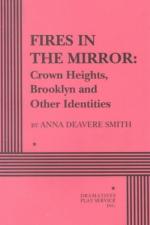|
This section contains 299 words (approx. 1 page at 400 words per page) |

|
Fires in the Mirror Summary & Study Guide Description
Fires in the Mirror Summary & Study Guide includes comprehensive information and analysis to help you understand the book. This study guide contains the following sections:
This detailed literature summary also contains Bibliography on Fires in the Mirror by Anna Deavere Smith.
In 1991, in the Crown Heights section of Brooklyn, New York, a member of the Lubavitch branch of Hasidic Judaism lost control of his car, jumped the curb, and killed a seven-year-old black child. This incident and the circumstances surrounding it led to a period of extremely high tension between the black community and the Jewish community in Crown Heights, including riots and the murder of the Lubavitcher Jew, Yankel Rosenbaum. As these events were unfolding, Anna Deavere Smith began a series of interviews with many of those involved in the conflict as well as those who were able to make key insights into its nature, its causes, and its results. In her play Fires in the Mirror, first produced in New York City in 1992, Smith distills these interviews into monologues by twenty-six different characters, each of whom provides an important and differing view on the situation in Crown Heights.
When Smith performs her play, she acts in the role of each interviewee, embodying his/her voice and movements, and expressing his/her message and personality. These perspectives combine to form a profound explanation of the conflicts between the different Crown Heights communities. Smith examines many of the historical causes of the situation, many of the racial theories that help to explain it, and a broad variety of opinions on the events and people involved, in order to come closer to the truth about what happened and why. Her play, which is the thirteenth part of her unique project On the Road: A Search for the American Character combines journalism and drama in order to examine not just the racial tension and violence in Crown Heights, but much broader themes, including racial, religious, gender, and class identity, and the historical conflict between these communities in the United States.
Read more from the Study Guide
|
This section contains 299 words (approx. 1 page at 400 words per page) |

|



